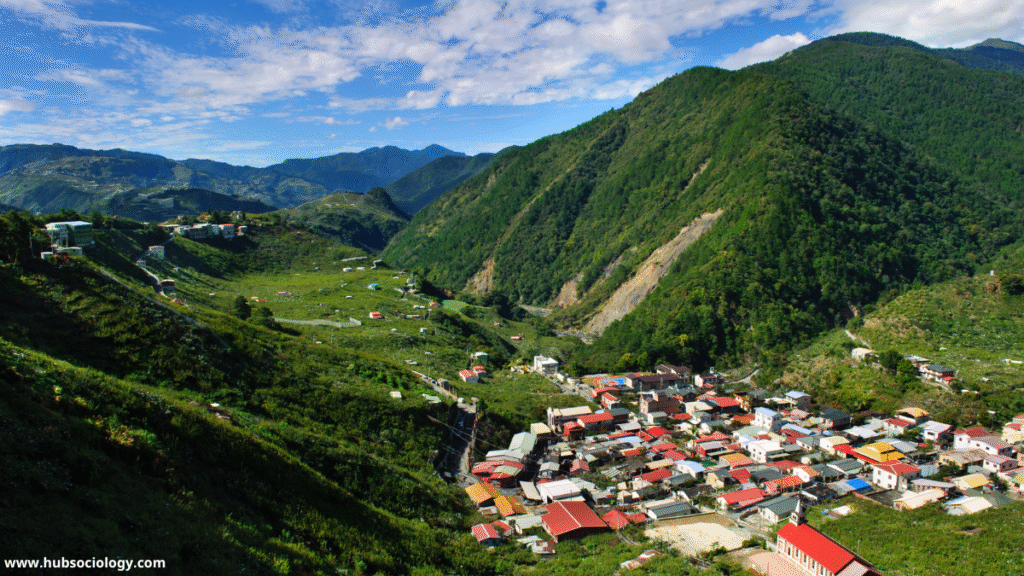Introduction
The idea of self-sufficiency in traditional Indian villages has been a subject of great interest among sociologists, economists, and policymakers. Indian villages were romanticized by colonial administrators such as Charles Metcalfe as “little republics” that were socially cohesive and economically autonomous. Mahatma Gandhi, too, idealized the self-sufficient village as the foundation of India’s development. However, with modernization, globalization, and state intervention, the notion of village self-sufficiency has been questioned. This article examines whether traditional Indian villages were truly self-sufficient or if this concept is a myth constructed by colonial and nationalist narratives.

Historical Perspectives on Village Self-Sufficiency
Colonial and Nationalist Views
British administrators like Charles Metcalfe and Henry Maine described Indian villages as self-contained units with their own governance, economy, and social structures. According to them, villages produced their own food, maintained local crafts, and resolved disputes through panchayats without external interference.
Gandhi’s vision of Gram Swaraj (village self-rule) reinforced this idea. He believed that villages should be autonomous, self-reliant, and free from external exploitation. However, scholars like D.D. Kosambi and Ramachandra Guha argue that this view was idealized and ignored the complex interdependencies between villages and larger economic systems.
Critiques of the Self-Sufficiency Narrative
Historical evidence suggests that Indian villages were never entirely isolated. Trade networks connected villages to towns and cities for salt, metals, spices, and luxury goods. The jajmani system, where service castes (like blacksmiths, potters, and weavers) provided goods in exchange for grain, created interdependence rather than complete self-sufficiency.
Sociologist M.N. Srinivas noted that villages were part of a larger feudal and later colonial economy where surplus extraction (through taxes, rents, and forced labor) made absolute self-sufficiency impossible. The British land revenue systems (like the Zamindari and Ryotwari systems) further integrated villages into a cash economy, reducing their autonomy.
Economic Dimensions of Self-Sufficiency
Agriculture and Food Production
Traditional Indian villages primarily relied on subsistence agriculture. Farmers grew food crops like wheat, rice, and millets for local consumption. However, droughts, famines, and feudal exploitation often disrupted food security. The Green Revolution in the 1960s introduced cash crops and market dependencies, further diminishing self-sufficiency.

Crafts and Artisanal Production
Villages had localized craft production—pottery, weaving, and metalwork—but these were often linked to regional markets. Colonial policies destroyed many indigenous industries (like handloom textiles), forcing villages to depend on manufactured goods.
Monetization and Market Dependence
Barter systems existed, but monetization was always present, especially under Mughal and British rule. Post-independence, government schemes (like MNREGA) and banking penetration increased cash flow, reducing traditional barter systems.
Social Structures and Interdependence
Caste and the Jajmani System
The jajmani system was a key feature of village self-regulation, where different castes provided services in exchange for a share of agricultural produce. However, this system was hierarchical and exploitative, with lower castes often facing oppression. Modernization and urbanization have weakened this system, leading to greater dependence on wage labor and government welfare.
Gender Roles and Labor
Women played a crucial role in maintaining household self-sufficiency through food processing, animal husbandry, and handicrafts. However, their labor was often unpaid and undervalued. Today, male migration for work has increased women’s burdens while reducing true self-sufficiency.
Political and Administrative Control
Panchayati Raj and Local Governance
Traditional panchayats managed local disputes and resource distribution, but their authority was limited by feudal lords and colonial administrators. Post-independence, the Panchayati Raj system formalized local governance but also tied villages to state and central policies, reducing autonomy.
Government Interventions and Welfare Schemes
Programs like the Public Distribution System (PDS), rural employment schemes, and subsidies have improved living standards but also increased dependence on state support. This contradicts the idea of complete self-sufficiency.
Modern Challenges to Village Self-Sufficiency
- Migration and Urbanization – Youth migration for jobs has left villages dependent on remittances.
- Climate Change – Erratic rainfall and soil degradation threaten agricultural independence.
- Globalization – Cheap industrial goods have replaced local artisans, making villages reliant on external markets.
- Technology and Education – While beneficial, digital access has created new dependencies (e.g., smartphones, online services).
Conclusion: Myth or Reality?
The idea of complete self-sufficiency in traditional Indian villages is largely a myth. While villages had a degree of autonomy, they were always connected to larger economic and political systems. Colonialism, capitalism, and modernization have further eroded any remaining self-reliance. However, elements of localized resilience—such as organic farming, traditional water management, and community cooperation—still exist and can be revitalized for sustainable development.

Rather than romanticizing the past, policymakers should focus on creating selective self-sufficiency—where villages produce essential goods locally while engaging with modern markets in a balanced way. True empowerment lies not in isolation but in strengthening rural economies with fair access to resources, education, and technology.
Do you like this this Article ? You Can follow as on :-
Facebook – https://www.facebook.com/hubsociology
Whatsapp Channel – https://whatsapp.com/channel/0029Vb6D8vGKWEKpJpu5QP0O
Gmail – hubsociology@gmail.com
Topic Related Questions
5-Mark Questions (Short Answer Type)
- Define the concept of self-sufficiency in the context of traditional Indian villages.
- What was the jajmani system, and how did it contribute to village economy?
- How did British colonial policies impact the self-sufficiency of Indian villages?
- Explain Gandhi’s idea of Gram Swaraj in relation to village self-sufficiency.
- What role did caste play in maintaining village self-sufficiency?
- How did the Green Revolution affect agricultural self-sufficiency in Indian villages?
- Briefly discuss the role of women in sustaining traditional village economies.
- What were the limitations of the panchayat system in ensuring village autonomy?
- How has migration affected self-sufficiency in rural India?
- Name two government schemes that have influenced rural self-sufficiency in post-independence India.
10-Mark Questions (Detailed Answer Type)
- Critically examine the colonial and nationalist perspectives on self-sufficiency in Indian villages.
- Discuss the economic interdependencies in traditional Indian villages with reference to the jajmani system.
- How did feudal and zamindari systems challenge the idea of village self-sufficiency?
- Analyze the impact of globalization on traditional crafts and artisanal work in rural India.
- “The Green Revolution reduced food insecurity but increased market dependence.” Comment.
- How has the Panchayati Raj system influenced village self-governance and self-sufficiency?
- Discuss the changing gender roles in rural economies and their effect on self-sufficiency.
- What are the major environmental challenges to agricultural self-sufficiency in villages today?
- Compare the self-sufficiency of pre-colonial villages with post-independence rural economies.
- How do government welfare schemes both support and undermine village self-reliance?
15-Mark Questions (Essay-Type/Long Answer)
- “The idea of self-sufficient Indian villages is more of a myth than reality.” Critically evaluate this statement with sociological evidence.
- Analyze the role of caste, class, and gender in shaping the economic self sufficiency of traditional Indian villages.
- How did colonialism and post-independence economic policies transform the self sufficiency of rural India?
- Discuss the sustainability of traditional village economies in the era of globalization and digitalization.
- Can India revive village self sufficiency in the 21st century? Suggest measures based on Gandhian and modern developmental perspectives.
- Examine the impact of migration, urbanization, and climate change on rural self sufficiency in contemporary India.
- “Self sufficiency in villages was never absolute but existed in a continuum of interdependence.” Elaborate with examples.
- How have government policies like MNREGA, PDS, and agricultural subsidies affected rural self-reliance?
- Compare the self sufficiency models of tribal villages with mainstream agrarian villages in India.
- What lessons can modern India learn from traditional village systems to build sustainable rural economies?

1 thought on “Self-Sufficiency in Traditional Indian Villages: Myth or Reality?”